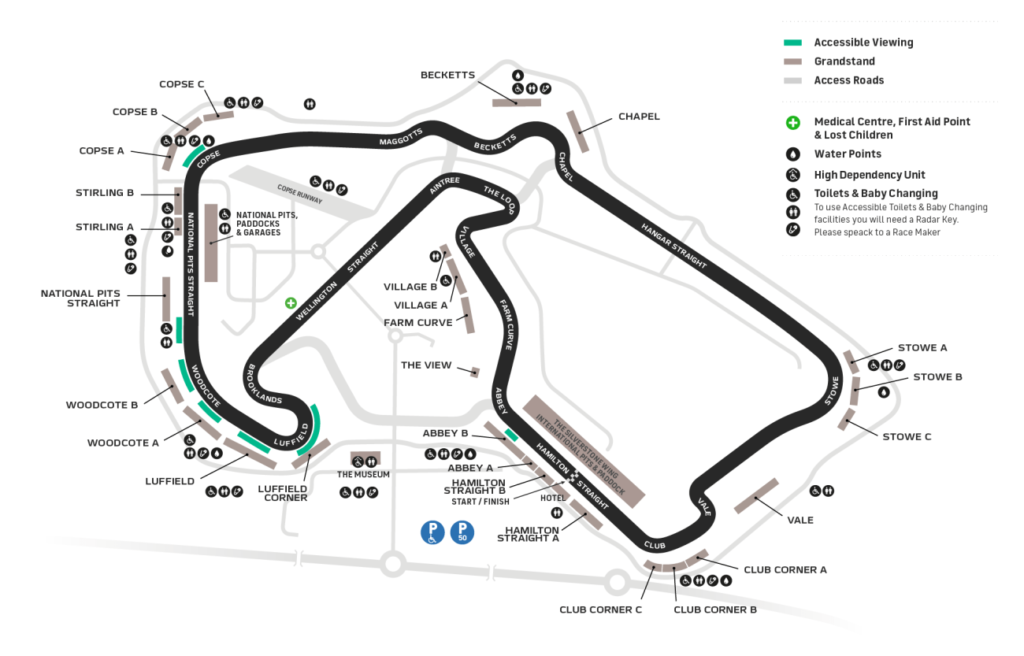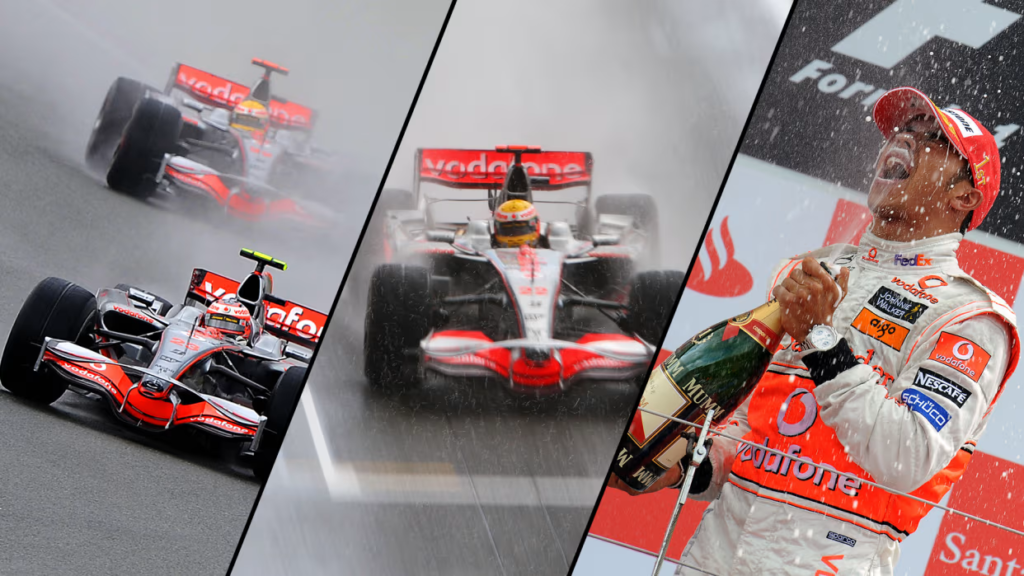There are few circuits that hold the same iconic status as Silverstone. Known as the “Home of British Motorsport,” Silverstone has not only been a cornerstone of Formula 1 history but also a thrilling stage for some of the sport’s most memorable moments.
In this post, we’ll take a deep dive into Silverstone’s history, layout, iconic moments, and why it remains one of the most beloved circuits in the Formula 1 calendar.
A Brief History of Silverstone
Silverstone’s roots date back to World War II when it served as a Royal Air Force bomber station. After the war, the deserted airfield was transformed into a racetrack, with the first-ever Formula 1 World Championship race held there on May 13, 1950. The British Grand Prix, hosted by Silverstone, marked the dawn of a new era in motorsport.
Over the decades, Silverstone has undergone significant changes. The original layout, using the airfield’s runways and perimeter roads, was fast and flowing. In 1991, a major redesign introduced tighter corners and chicanes, making the track more technical while maintaining its high-speed character. The most recent update in 2010 brought the “Arena” section, further enhancing overtaking opportunities and modernizing facilities.
Despite these changes, Silverstone has retained its essence: a challenging, high-speed circuit that tests both driver skill and engineering precision.
Track Layout: A Blend of Speed and Skill
Silverstone’s 5.891-kilometer layout features 18 corners that demand a perfect balance of speed, precision, and bravery. Let’s break down some of the key sections:
Maggotts, Becketts, and Chapel
Arguably the most famous sequence of corners in Formula 1, this high-speed complex is a favorite among drivers and fans alike. Cars weave through at astonishing speeds, with precision steering and aerodynamic grip playing crucial roles. A slight error here can compromise a driver’s exit onto the Hangar Straight, one of the track’s best overtaking spots.
Copse Corner
Once the first corner of the circuit, Copse remains one of the fastest corners in Formula 1. Taking it flat out requires immense confidence and skill, making it a thrilling spectacle for fans watching trackside or on television.
The Loop and Aintree
This slower section, part of the newer Arena layout, challenges drivers with tight corners and traction-limited exits. It’s a prime spot for wheel-to-wheel action and often sets up overtakes onto the Wellington Straight.
Stowe Corner
Approached at high speeds from the Hangar Straight, Stowe tests a driver’s braking and cornering skills. Its slightly downhill entry and wide exit make it another overtaking hotspot.

Why Silverstone Is Loved by Fans and Drivers
The Atmosphere
Silverstone’s passionate crowd is second to none. With its location in the heart of Britain, a country deeply entwined with Formula 1 history, the circuit draws thousands of enthusiastic fans every year. The “British summer” may bring unpredictable weather, but that only adds to the drama and excitement.
A True Driver’s Track
Many drivers consider Silverstone a favorite thanks to its high-speed nature and technical challenges. The combination of sweeping corners and tight sections provides a unique test of car setup and driver skill.
Historic Significance
From hosting the first Formula 1 World Championship race to memorable battles over the decades, Silverstone’s legacy is unparalleled. Icons like Nigel Mansell, Lewis Hamilton, and Ayrton Senna have all left their mark on this hallowed ground.
Unforgettable Moments at Silverstone
1950: The First-Ever World Championship Race
Silverstone made history by hosting the inaugural Formula 1 World Championship race. Giuseppe Farina won the race for Alfa Romeo, setting the stage for what would become the pinnacle of motorsport.
1987: Nigel Mansell’s “Charge of the Light Brigade”
In one of Silverstone’s most iconic races, Nigel Mansell thrilled the home crowd with a stunning comeback to overtake his Williams teammate Nelson Piquet and claim victory. The scene of fans flooding the track afterward remains etched in F1 lore.
2008: Lewis Hamilton’s Masterclass
A young Lewis Hamilton showcased his wet-weather prowess in the 2008 British Grand Prix. Despite torrential rain, Hamilton dominated the field, winning by over a minute in one of the greatest drives of his career.

2019: Verstappen vs. Leclerc
The 2019 race featured an intense battle between future stars Max Verstappen and Charles Leclerc. Their wheel-to-wheel racing through Silverstone’s fast corners was a masterclass in skill and respect.
The Role of Silverstone in Modern F1
In today’s Formula 1, Silverstone continues to be a cornerstone of the calendar. It’s a track where teams bring significant upgrades due to its timing in the season and its importance as a testing ground for aerodynamic efficiency.
The circuit’s fan-friendly atmosphere, combined with modernized facilities, ensures that it remains a highlight for spectators. Events like the Silverstone Festival and fan zones create a vibrant race-weekend experience.
Sustainability at Silverstone
In recent years, Silverstone has embraced sustainability initiatives, aligning with Formula 1’s goal of becoming net zero by 2030. Measures include improved waste management, renewable energy use, and efforts to reduce single-use plastics at events. These initiatives ensure that Silverstone remains a world-class venue while contributing to a greener future for motorsports.
Planning Your Visit to Silverstone
If you’re considering attending the British Grand Prix, here are some tips to make the most of your trip:
- Book Early: Tickets sell out quickly, especially for popular grandstands like those overlooking Copse and Becketts.
- Arrive Prepared: British weather is famously unpredictable, so bring layers, waterproofs, and sunscreen.
- Explore the Circuit: Take time to walk around the track and enjoy the views from different corners. Each section offers a unique perspective on the action.
- Engage with Fan Zones: From driver interviews to merchandise stalls, the fan zones offer a wealth of entertainment.
Silverstone’s Future
As Formula 1 evolves, so does Silverstone. The circuit’s commitment to modernization and sustainability ensures it will remain a key part of the calendar for years to come. With its perfect blend of heritage, cutting-edge racing, and passionate fanbase, Silverstone is truly the beating heart of British motorsport.
Final Thoughts
Silverstone isn’t just a race track; it’s a symbol of Formula 1’s rich history and exciting future. Its combination of high-speed thrills, technical challenges, and a vibrant atmosphere makes it a must-see for any motorsport fan. Whether you’re watching from the stands, the comfort of your home, or dreaming of a future visit, Silverstone promises unforgettable moments that capture the essence of Formula 1.
So, here’s to the “Home of British Motorsport,” where legends are made, and history is written—at 200 miles per hour.